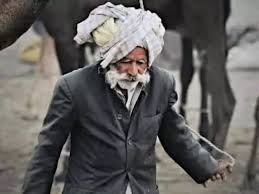
Ranchhoddas
Ranchhoddas Rabari, widely known as Ranchhod Pagi, was an extraordinary figure renowned for his exceptional skills in tracking and reconnaissance, particularly during his service in the Indian armed forces. Born into the Rabari community, traditionally pastoralists and camel herders, Ranchhoddas harnessed his deep knowledge of the terrain and wildlife to become a master tracker, a skill revered and sought after in military operations.
Early Life
Ranchhoddas was born in the early 20th century in the village of Nadabet in Gujarat, India. The Rabari community’s intimate connection with nature and their nomadic lifestyle provided him with a unique upbringing, where he learned to read animal tracks, understand the nuances of the desert landscape, and survive in harsh conditions. These skills, honed from a young age, would later prove invaluable to the Indian military.
Career in the Military
Ranchhoddas Pagi’s journey into military service began during the tumultuous period leading up to and following India’s independence in 1947. Recognizing his unmatched tracking abilities, the Indian Border Security Force (BSF) enlisted his help in patrolling and securing the sensitive borders of the newly independent nation.
His expertise was particularly crucial during the conflicts with Pakistan, including the wars in 1965 and 1971. Ranchhoddas could accurately interpret the faintest of tracks in the desert, distinguish between human and animal footprints, and even identify the number of people in a group, their direction, and how long ago they had passed. His abilities helped the Indian forces intercept enemy infiltrators, navigate the challenging terrains of the Rann of Kutch and the Thar Desert, and safeguard vital national interests.
Notable Contributions
Ranchhoddas Pagi’s contributions were not limited to just tracking enemy movements. He played a significant role in several critical operations:
1. 1965 Indo-Pak War: His tracking skills were instrumental in locating Pakistani infiltrators, thereby preventing potential attacks and saving countless lives.
2. 1971 Indo-Pak War: His guidance helped Indian forces in navigating the difficult terrains and achieving strategic advantages in the war.
For his exemplary service, Ranchhoddas received numerous accolades and recognition from the Indian government and military. His contributions were often acknowledged in military briefings and debriefings, and he became a legendary figure in the BSF.
Later Life and Legacy
After retiring from active service, Ranchhoddas continued to live in Gujarat, where he was revered as a local hero. His legacy is remembered not only for his military contributions but also for the way he bridged the traditional knowledge of his community with the modern needs of a nation at war.
In 2018, the Indian government honored him posthumously with a statue at the BSF Camp in Nadabet, recognizing his invaluable contributions to national security. Ranchhoddas Pagi remains an iconic figure, symbolizing the profound impact of indigenous knowledge and skills in modern warfare and national defense.
Ranchhoddas Rabari’s acquaintance with Field Marshal Sam Manekshaw, one of India’s most celebrated military leaders, is a testament to the mutual respect and admiration between a local tracker and a top military strategist. Their interactions were marked by significant moments that highlighted Ranchhoddas Pagi’s exceptional skills and contributions to the Indian military.
Initial Acquaintance
During the 1965 Indo-Pak War, Ranchhoddas Pagi’s extraordinary tracking abilities came to the attention of senior military officers, including Sam Manekshaw, who was then a Lieutenant General. Manekshaw, known for his keen eye for talent and his respect for ground intelligence, quickly recognized the value of Ranchhoddas’s unique skills in the challenging terrains of Gujarat.
Working Relationship
The acquaintance between Ranchhoddas and Manekshaw deepened during the conflicts. Ranchhoddas’s unparalleled ability to read tracks and interpret the desert landscape provided critical intelligence that proved invaluable in several military operations. His insights helped Manekshaw and his troops navigate the difficult terrains of the Rann of Kutch, locate enemy positions, and strategize effective responses.
Manekshaw, a leader known for his charisma and ability to inspire his troops, often highlighted the importance of local knowledge and expertise in military success. He held Ranchhoddas in high regard, frequently consulting him for his insights and involving him in key reconnaissance missions. Their collaboration showcased a remarkable synergy between modern military strategy and traditional tracking skills.
Recognition and Respect
Sam Manekshaw’s respect for Ranchhoddas was evident in the way he acknowledged the latter’s contributions. Despite the hierarchical differences and the cultural gap, Manekshaw valued Ranchhoddas’s expertise, often citing his role in successful operations. This mutual respect helped cement Ranchhoddas’s position as a crucial asset to the Indian military.
Legacy
The acquaintance between Ranchhoddas Rabari and Sam Manekshaw is remembered as a powerful example of how diverse skills and backgrounds can come together to achieve significant military successes. Manekshaw’s recognition and appreciation of Ranchhoddas’s skills not only highlighted the importance of indigenous knowledge but also set a precedent for future military engagements in similar terrains.
In many ways, their relationship symbolized the fusion of traditional wisdom and modern military tactics, contributing to the rich legacy of India’s military history. Ranchhoddas’s work, supported and recognized by leaders like Sam Manekshaw, remains a proud chapter in the annals of the Indian armed forces.
Paagi-Paagi
In 2008, Field Marshal Manekshaw was admitted to Wellington Hospital, Tamil Nadu. In his serious illness and semi-conscious state, he would often take one name – ‘Paagi-Paagi!’ One day the doctors asked, “Sir, who is this Paagi?”
Sam sahab himself briefed…
1971 India had won the war. General Manekshaw was in Dhaka. He ordered to call Paagi. He would have dinner with him today. A helicopter was sent. While boarding the helicopter, one of Paagi’s bags was left behind. The helicopter was landed back to pick it up. As per the rules, the officers opened the bag before placing it in the helicopter and were stunned because it contained two rotis, onions and a dish made of gram flour (gathia). In dinner, Sam sahab ate one roti and Paagi ate the other.
A border post in Suigaon International Border area of North Gujarat was named Ranchhoddas post. This was the first time that an army post was named after a common man and his statue was also installed.
Paagi means guide, the person who shows the way in the desert. General Sam Manekshaw used to call Ranchhoddas Rabari by this name.
Ranchhoddas was from Pethapur Gathdo village adjacent to Pakistan border in Banaskantha district of Gujarat. He used to rear sheep, goats and camels. His life changed when at the age of 58, Banaskantha Superintendent of Police Vanraj Singh Jhala appointed him as a police guide.
His skill was such that he could tell how many people were riding on a camel by looking at its footprints. He could estimate everything from weight to age by looking at human footprints. He could estimate how long ago the footprints were and how far they might have gone with utmost accuracy as if a computer was doing the calculations.
At the beginning of the 1965 war, Pakistan Army captured Vidhkot situated on the Kutch border in Gujarat, India. In this encounter, about 100 Indian soldiers were killed and a contingent of 10000 soldiers of the Indian Army had to reach Charkot in three days. Then Ranchhoddas Pagi was needed for the first time! Due to his command over the desert routes, he had taken the army to its destination 12 hours before the scheduled time. He was personally selected by Sam Saheb to guide the army and a special post was created in the army – ‘Pagi’ which means expert of feet.
He had informed the Indian Army about the location and estimated number of 1200 Pakistani soldiers hiding in the Indian border by finding out their footprints only, and this was enough for the Indian Army to win that front.
In the 1971 war, along with guiding the army, it was also part of Pagi’s work to deliver ammunition to the front. Pagi played an important role in the victory in which the Indian tricolor was hoisted on the Palinagar city of Pakistan. Sam Saab himself gave a cash prize of ₹300 from his pocket.
Pagi also received three honors for his contribution in the 65 and 71 wars – Sangram Medal, Police Medal and Samar Seva Medal!
Sam Manekshaw died on 27 June 2008 and in 2009, Pagi also took ‘voluntary retirement’ from the army. Pagi was 108 years old then! Pagi died in 2013 at the age of 112.
Ranchhoddas Rabari’s exemplary contributions to the Indian Army are a testament to his extraordinary skills and dedication. His unmatched tracking abilities and intimate knowledge of the desert terrains played a crucial role in several military operations, particularly during the Indo-Pak wars of 1965 and 1971. His collaboration with esteemed military leaders, such as Field Marshal Sam Manekshaw, highlighted the invaluable integration of indigenous expertise into modern military strategy. Ranchhoddas’s legacy endures as a symbol of the profound impact that traditional knowledge can have on national security and defense.
By: SIDHARTHA MISHRA
Write and Win: Participate in Creative writing Contest & International Essay Contest and win fabulous prizes.


